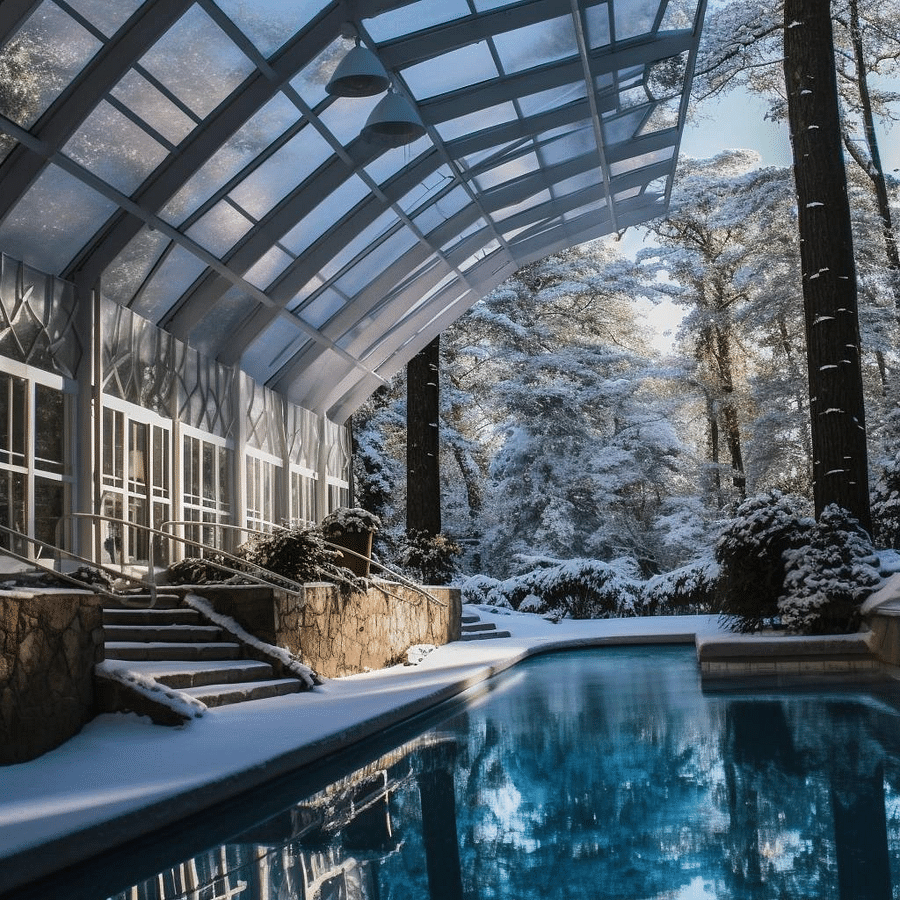- Winterizing your pool is important to protect your investment and prevent costly damage from freezing temperatures.
- Winterizing your pool saves time and effort when reopening in the spring by reducing algae growth and water chemistry balancing.
- Winterizing your pool ensures the safety of your pool area during the off-season by securely covering the pool.
- Cleaning and balancing the water is the first step in winterizing your pool, including thorough cleaning, water testing, and adding a winterizing chemical kit.
Your Guide to Preparing Your Pool for the Off-Season!
❄️ As the leaves start to fall and the temperatures begin to dip.
It's time to bid farewell to poolside lounging and prepare your swimming pool for winter slumber.
Winterizing your pool is essential for protecting its components and ensuring a smooth transition into the next swimming season.
This guide'll uncover the steps to winterize your pool, helping you navigate the frosty waters and ensure your pool emerges from hibernation in pristine condition.

Why Winterizing Your Pool is Important
As the leaves start to fall and the temperature drops, it's time to think about winterizing your swimming pool.
But why is this step so crucial in your pool maintenance during winter?
Let's dive in!
- Firstly, winterizing your pool helps to protect your investment. Pools are a significant financial commitment; neglecting to prepare your pool for winter can lead to costly damage. Freezing temperatures can cause water to expand, potentially cracking your pool's walls, pipes, and equipment. You can prevent these issues by following the right inground pool closing steps or steps to close an above-ground pool.
- Secondly, winterizing your pool can save time and effort when the swimming season rolls around again. An adequately winterized pool is easier to reopen in the spring. You'll spend less time battling algae growth and balancing your water chemistry and more time enjoying your pool.
- Finally, winterizing your pool is an essential part of off-season pool maintenance that ensures the safety of your pool area during the colder months. A securely covered pool reduces the risk of accidents, making your backyard safer during the off-season.

Step 1: Clean and Balance the Water
Now that we've established the importance of winterizing your pool let's dive into the first step: Cleaning and Balancing the Water. This step is crucial in preparing your pool for winter and is a vital part of both inground pool closing steps and steps for closing an above-ground pool.
- Begin by giving your pool a thorough cleaning. This includes brushing the walls and floor, vacuuming, and skimming the surface to remove debris. Remember, a clean pool now means less work when it's time to reopen in the spring.
- Next, it's time to balance your pool water. This is an essential part of pool maintenance during winter as it helps prevent the growth of algae and bacteria. Test your water for pH, alkalinity, and calcium hardness. The ideal pH level is between 7.2 and 7.6; alkalinity should be between 80 and 120 parts per million (ppm), and calcium hardness should be between 180 and 220 ppm for concrete pools or 175 to 225 ppm for vinyl pools.
- Once your water is balanced, add a winterizing chemical kit. These kits are designed to keep your water clear and blue for the next season. Follow the manufacturer's instructions for the best results.

Lastly, don't forget to shock your pool. This super-chlorination process kills bacteria and other microorganisms, ensuring a clean and healthy pool for the next season. Use a non-chlorine shock for this step, as it won't harm your pool equipment.
By cleaning and balancing your pool water, you're setting the stage for a successful winterization process. This is the first step in our professional pool winterization guide, and it's a crucial part of ensuring your pool is ready for the off-season.
Step 2: Lower the Water Level
Moving on to the next step in our comprehensive guide to winterizing your swimming pool, we'll focus on lowering the water level. This is a critical part of the inground pool closing procedure and the steps to close an above-ground pool. It's also an essential aspect of off-season pool maintenance that should not be overlooked.
- Why do we need to lower the water level, you might ask? Well, when water freezes, it expands. The expanding ice could damage your pool walls or skimmer if your pool is filled to the brim. Lowering the water level helps to prevent this from happening.
- The water level should be lowered below the skimmer mouth for inground pools but not more than 6 inches. This can be achieved using your pool's pump or a submersible pump. Lower the water level approximately 4-6 inches below the skimmer for above-ground pools.

- Remember, it's essential to monitor the water level throughout the winter. If you live in an area with heavy rainfall, you may need to lower the water level further to accommodate the additional water. Conversely, in drier climates, you may need to add water to maintain the appropriate level.
- By carefully managing the water level in your pool, you're taking a significant step towards successful pool maintenance during winter. This is a critical step in our professional pool winterization guide and is essential for preparing your pool for the off-season.
Step 3: Remove and Store Pool Accessories
Now that we've successfully managed the water level in your pool, it's time to move on to the next step in our swimming pool winterization tips: Step 3: Remove and Store Pool Accessories. This step is crucial in the inground pool closing steps and the steps to close an above-ground pool.
- Pool accessories such as ladders, slides, toys, and diving boards can become damaged if left in the pool during the off-season. The freezing temperatures can cause these items to crack or break, leading to costly repairs or replacements. Therefore, it's best to remove them before winter hits.
- Start by removing any pool toys or floating devices. These items are typically made of plastic and can become brittle in cold weather. Next, remove more extensive accessories like ladders and slides.

Once you've removed all accessories, it's time to store them properly. Clean each item thoroughly to remove any chlorine or other chemicals that could cause damage over time. After cleaning, dry each item completely to prevent mold and mildew growth. Finally, store your pool accessories in a dry, protected area such as a shed or garage.
Remember, proper off-season pool maintenance goes beyond just the water and the pool itself. By removing and storing your pool accessories properly, you're ensuring they'll be ready to use when the warm weather returns. This is another crucial step in our professional pool winterization guide and an essential part of preparing your pool for winter.
Step 4: Winterize the Plumbing System
As we continue our journey through the essential steps to winterize your swimming pool, we've arrived at a crucial stage: Step 4: Winterize the Plumbing System. This step is pivotal in both the inground pool closing procedure and the steps for closing an above-ground pool. It's all about protecting your pool's plumbing from potential freeze damage during winter.
- First, you'll need to drain the water from your pool's plumbing system. This includes the pump, heater, and filter. You can do this by setting your filter valve to the 'winterize' setting if it has one and removing the drain plugs.

- Next, it's time to blow out the lines. This process involves forcing air through the plumbing system to remove any remaining water. If water is left in the lines, it can freeze and expand during the winter, causing severe damage. A shop vacuum or a specialized pool blower can be used for this task.
- Plug the return lines once the lines are clear to prevent water from re-entering the system. You can use expandable rubber plugs for this purpose.

- Finally, add pool antifreeze to the lines for an extra layer of protection. Use a pool-specific antifreeze, as automotive antifreeze can damage your pool's plumbing.
- By following these swimming pool care in off-season steps, you're preparing your pool for winter and ensuring a smoother and less costly opening when the swimming season returns. Remember, every step you take now in winterizing your pool will save you time, effort, and money in the long run.
Step 5: Cover and Secure the Pool
Step 5 in our professional pool winterization guide covers and secures your swimming pool. This is a crucial step in preparing your pool for winter, whether you're dealing with an above-ground or inground pool.
Covering your pool is essential to protect it from harsh winter elements. It also helps to keep out debris, leaves, and even unwanted critters.

A pool cover is a vital tool in your off-season pool maintenance arsenal.
- When choosing a pool cover, ensure it's sturdy and designed for winter use. It should withstand the weight of snow and ice without tearing. If you're closing an above-ground pool, the cover should have a cable and winch system to secure it tightly around its edge. Water bags or weights can be used to hold the cover in place for inground pools.
- Securing your pool is equally important. This involves ensuring all entry points, like gates and doors, are locked. This is a safety measure and a way to prevent unauthorized access to your pool during the off-season.
- Remember, winterizing your pool is not just about preserving its condition but also about ensuring safety. As a pool safety advocate, I cannot stress enough the importance of these steps in your pool maintenance during winter.
So, please don't skip this step, whether you're following our step-by-step guide for closing an above-ground pool or our inground pool closing procedure. Cover and secure your pool to keep it safe and ready for the next swimming season.
Step 6: Regular Maintenance During the Off-Season
Now that we've covered the importance of securing your pool let's dive into the sixth step of our professional pool winterization guide: Regular Maintenance During the Off-Season. Even when your pool is closed for the winter, it still needs some TLC to ensure it remains in top condition for the next swimming season.
Off-season pool maintenance involves periodic checks on your pool cover.

- Ensure it's still secure and free from damage. Heavy snowfall or strong winds can sometimes dislodge pool covers or cause tears. If you notice any damage, repair it immediately to prevent debris from entering and contaminating your pool.
- Another crucial part of pool maintenance during winter is monitoring the water level. If you're winterizing an inground pool, the water level should not rise above the skimmer. For above-ground pools, the water should not touch the cover. If you notice a significant increase in the water level, use a submersible pump to remove the excess water.
- Lastly, don't forget about pool inspection during the off-season. This includes checking the pool's structure for any signs of damage or wear and tear. If you spot any issues, it's best to address them immediately rather than wait for the swimming season to start.
- Remember, off-season pool maintenance aims to keep your pool in the best possible condition so that when the warm weather returns, your pool is ready for use with minimal effort. So, regular maintenance during the off-season is necessary, whether you're following our steps to winterize an inground pool or our guide for closing above-ground pool steps.
- As a pool safety advocate, I can assure you that taking the time to perform these checks and balances during the off-season will preserve your pool's condition and contribute to a safer swimming environment when it's time to dive back in.
Conclusion
Winterizing your swimming pool is like tucking it in for a long winter's nap, keeping it safe and sound until the warmer days return.
Following the proper steps to protect your pool's equipment, balance its water chemistry, and safeguard against freezing temperatures, you'll set yourself up for a hassle-free reopening when spring arrives.
So, bid farewell to poolside fun for now, and embrace the winterizing journey. This necessary task will preserve the beauty of your pool and have you eagerly awaiting the next season's splash-filled adventures!












Post a comment